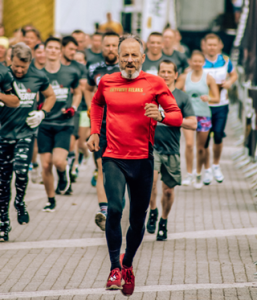Let me stop you right there.
Unless that sentence ends with “start training to be on the national gymnastics team”, “hang out in the high school playground at lunchtime,” or “become a flight attendant for Emirates Airlines”, then no, you’re probably not too old.
If there’s an activity you want to train for, then age alone should not rule it out – why stop living before you’re actually dead?
It’s true that you may have to be more patient with your progress and it’s possible that you may not perform at the same level as if you had attempted the activity when you were 22. But these are no reasons to stop you having a go.
We’ve all seen elite and professional athletes quit because “they got too old”. Before we look at physical limitations of age, let’s check off some of the other reasons athletes get “too old” for a sport.
Injury – at the top level, physical trauma from the sport or repetitive strain means that past or existing injury may limit their capacity to perform. This doesn’t put them out forever. Once they take time away from the game to actually heal properly, many former pro athletes still enjoy their old glory sport at some level because their body can handle it just fine once they no longer have to perform at the frequency and/or intensity of the top level.
Motivation – intense pressure over several years takes its toll and athletes simply can’t bring themselves up to perform again. Sport can be overtaken by other factors in their life fighting for top priority, like family, holidays and chocolate cake. Other times they just get bored and now they want to live a little.
One thing that is very interesting to note in many sports is that ‘increased professionalism’ – that is, the ability to earn more money than previous athletes did – has coincided with many athletes continuing in their sport and performing well at ages that were unheard of a couple decades ago. Did humans evolve so much in 20 years? No, obviously not, especially if you look at world politics. Athletes just had more motivation to stay fit, train well, eat well, and they had better access to more advanced sports science, medical and nutritional support services.
If there’s an activity you want to train for, then age alone should not rule it out – why stop living before you’re actually dead?
Those of you not diving into an activity off the back of a professional sports career probably have some additional factors holding you back:
- A lack of activity and age may have made your muscles, ligaments and tendons less flexible
- You have lost your base level of fitness, which is harder to regain after you early 20s
- You have lost muscle and strength, and-or gained weight
If you look at the facts about physiological performance and age alone on paper, it can all make for some depressing reading. However, before you start thinking that the ’27 Club’ was actually a good idea, there are three main factors to bear in mind:
- These declines can be slowed and even stopped for a while if you take action to fight back against them
- In many activities, adaptations can be made to overcome decline in certain areas, with little or no decline in overall performance
- Overall performance is a synergy of factors which take in both the physical and the mental side – this is why an older athlete with more experience to call on, more discipline and mental fortitude to call on from a broad range of life experiences can often do as well or better than a younger person who should have the edge physically.
Besides, all this goes out the window when you stop comparing yourself to the 22-year-old super-athlete you could have been and start looking at how much more active, athletic and healthy you can be than the X-year-old you are right now.
So let’s get the buzzkills over with first. A list of physiological attributes that decline naturally (i.e. unless action is taken to prevent otherwise) include these points, roughly in order of age:
- Coordinated skills learning – many high-coordination actions, e.g. gymnastics, weightlifting, are best learnt in early childhood
- Flexibility – flexibility training while the body is still forming is much more effective and happens more quickly than in adulthood, when the bone plates are fixed and the soft tissue (muscles, ligaments, tendons) are less malleable
- Sarcopenia – that’s the term for the loss of muscle mass that occurs naturally after our mid-20s unless we move to stop it. This gets much worse after age 50 as natural levels of testosterone and growth hormone plummet. This muscle mass is also associated with a slowdown of metabolism that can cause weight gain unless food intake and activity are modified
- So muscle mass declines with age – but particularly the proportion of fast twitch (speed and power-producing) muscle fibres – you lose as much as 30% between the ages of 20 and 80. As you get older, you are usually trying to produce speed and power with less of the relevant muscle fibres, which means those you have left will need to be well-conditioned!
- Bone mineral density (BMD) peaks at about age 25 and unless you do some resistance training, it’s all downhill from there! Strong bones support your muscles and connective tissue both for your activity and prevention of fractures that can set you back for months.
- Reaction time declines from late 20s and early 30s. Athletes often deliberately and subconsciously adapt to this by removing high-risk movements (e.g. a cricketer may stop playing the hook shot) or experience and training help them to ‘read the play’ better so that they can anticipate or recognise markers that indicate what is coming next rather than having to rely on reaction alone (e.g. a boxer may learn indicators that a particular boxer is about to throw a left hook by a slight drop in his shoulder).
- cardiorespiratory capacity (“oxygen uptake”) diminishes
All these things can be countered to a significant extent so that you can once again laugh in the face of age. It’s also worth noting that older athletes often do well – and even excel – in endurance and ultra-endurance activities. Even the athlete level, women’s endurance performance peaks in the 30s rather than the 20s. The longer the activity, the less the cards are stacked against your age. While you may have lost fast-twitch muscle fibres, the slow-twitch muscle fibres (predominantly used in endurance activities) remain. Overall muscle volume and strength becomes less important, yet things like psychological resilience, strategy, and recognising and respecting your body’s limits very often come much more naturally to the older person.

So if you want to be sure you won’t be “too old” for your chosen activity, here are some essential steps to follow:
Do resistance training
There’s no way around this. You need to do some resistance training – not much – even if you are training for an ultra-endurance activity.
Resistance training increases muscle strength by making your muscles work against a weight or force – that could be weights, rubber exercise tubing, your own body weight or a backpack or anything else that causes the muscles to contract.
Resistance training helps with injury avoidance. Among endurance athletes especially, the most common injuries tend to come from the stress of repetitive movements that lead to the breakdown of connective tissue – tendons, ligaments, fascia and cartilage. Weight training strengthens and hardens these structures to increase joint stability and help prevent injury.
It’s recommended that older athletes do resistance exercises at a fast tempo with slightly incomplete recovery, which means you may have to reduce the weight between sets to maintain the same speed and number of reps.
Get more bang for your buck by choosing exercises that:
- Use large muscles and several muscle groups at once
- require you to stand so that you work your core, your balance, connective tissue in key areas such as ankles, knees and hips
- Work a long range of motion – as long a range as you can control and work without pain
- Help even out any muscle imbalance, i.e. they work places where you are weaker or have less range of motion
- Include some plyometric work in a similar range will also help joint stability and fast-twitch muscle recruitment, but make sure you stop the set before you lose speed.
Train your fast-twitch muscle fibres
Again, even if you do ultra-endurance activity, you need to train to preserve your fast-twitch muscle capabilities. Fast twitch muscle fibre is not just for speed and power alone. Any time the body is under stress, fast twitch fibre will kick in to support slow twitch muscle fibre, e.g. even during fatigue stages in an endurance run.
You can train fast-twitch muscle fibres with short, sharp bursts of speed work or some kind of plyometric exercises. Plyometric exercise is when muscles are repeatedly and rapidly stretched (“loaded”) and then contracted, such as when you jump up onto a box or throw a medicine ball against a wall. This is a good way to train the muscles and the tissue around joints to handle a load, while also working speed and power.
Allow for more recovery
The more you exercise, the more recovery you will need, and you’ll certainly need to allow more and care than you ever needed in your teens and 20s! It’s not all about rest, either. Chuck everything you can at your recovery – stretching, massage, yoga, ice, heat packs (for tense muscles or muscles in spasm), compression clothing, etc.
Work in a little HIIT
No matter what your activity, HIIT (high intensity interval training) will help to maintain good cardiorespiratory capacity for stamina and ability to reach peak effort. This can be as little as one 20-minute session a week.
Cross train to save your joints and bones
Repetitive strain and stress hits harder as you age. Look for ways to vary your training – whether that’s for fitness, strength or especially endurance – so you don’t repeat the same stress again and again.
Train your reaction time
You can do this with drills for your sport, but it can also be as simple as a few ball drills at home and sitting on the couch playing some brain games on the computer to hone your reaction times.
Be specific with your training
Make sure you regularly have sessions that simulate the conditions and actions that you will require for your goal activity.
Eat for success
Older athletes are more vulnerable to chronic joint pain and stiffness, but you can hit back with your choice of food. Nutrients that will help include:
- Vitamin C for collagen formation
Omega-3 oils (from nuts, seeds, oily fish and wheat germ) for anti-inflammatory effects - Sulphur-containing amino acids (from some vegetables, meat, poultry, fish and dairy products) for joint cartilage health
- Bioflavinoids (from all fruit and vegetables, and buckwheat) for anti-inflammatory effects and improved local circulation
- Antioxidants (selenium and vitamin E) for protection against the damaging ‘free radicals’ that proliferate in the body with age
- A good serve of protein (20-30g) with every meal
- Nutrition for your tendons – vitamins A (green leafy vegetables, garlic, and, fish oils), C and E (olive oil, soy beans, egg yolks, nuts, seeds and green leafy vegetables), and there is now more evidence on the role of collagen and gelatin supplements for tendon health (note: these are non-vegan – vegans, it’s really too traumatic to explain).
Be patient!
Progress will always come with consistency and smart training. Rushing or pushing too hard will set you up for sickness or injury, which will only set you back.





